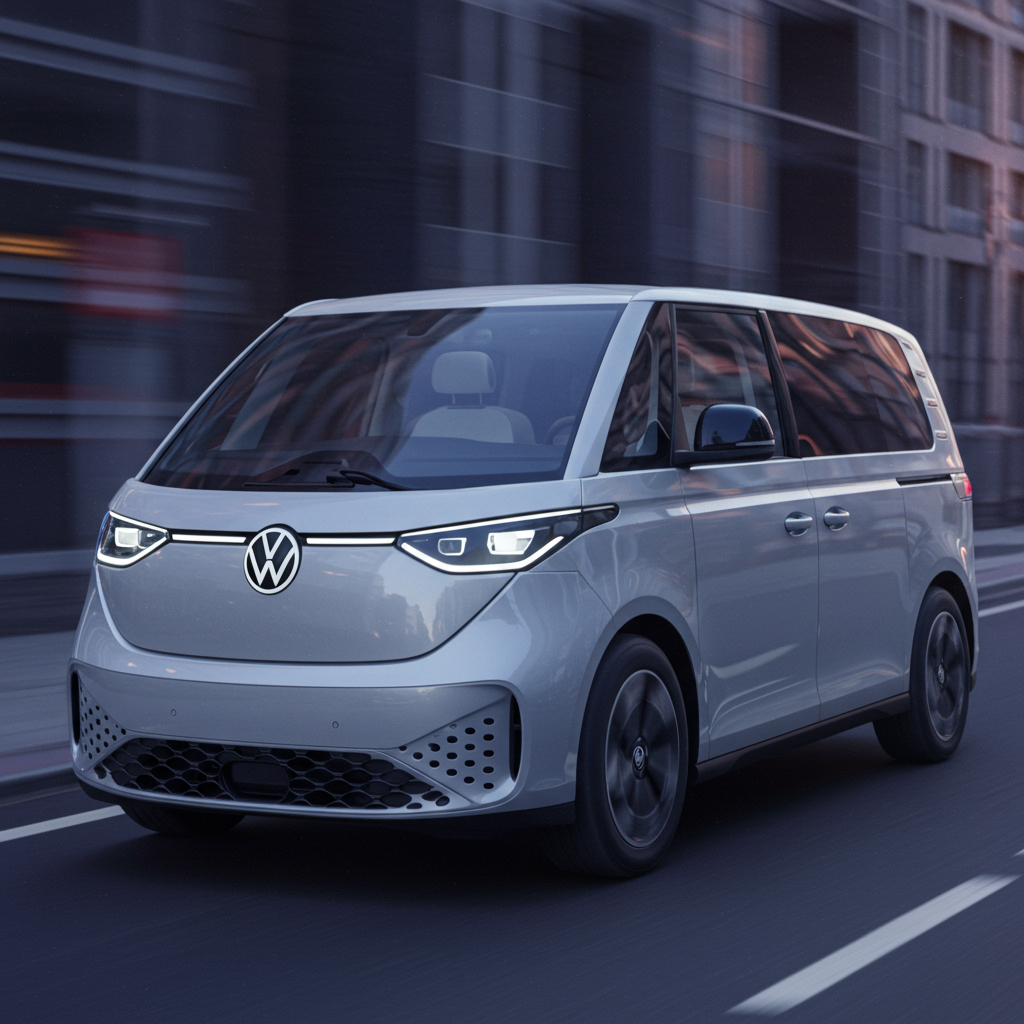The race for autonomous driving dominance is heating up, and European automotive giant Volkswagen is making a bold move, specifically targeting the burgeoning robotaxi market. While Tesla often grabs headlines with CEO Elon Musk’s ambitious predictions, VW recently unveiled a concrete plan centered around a familiar nameplate resurrected for the electric age: the iconic van, reimagined as the self-driving ID. Buzz AD.
With a planned launch set for 2026, VW is positioning its autonomous ID. Buzz variant as a direct competitor in the potentially lucrative driverless mobility sector, signaling its intent to challenge established players and perhaps even “overtake” rivals like Tesla in this specific segment.
VW’s ID. Buzz AD: A Concrete Step Towards Autonomous Mobility
Volkswagen Commercial Vehicles unveiled the production version of the autonomous ID. Buzz AD in Hamburg on June 17. This Level 4 self-driving electric van is designed to operate on set routes, offering a potential solution for transportation gaps, particularly in urban and rural areas where public transport may be insufficient.
Crucially, VW is not targeting private customers with the ID. Buzz AD. Instead, its strategy focuses squarely on business-to-business sales – supplying fleet operators, ride-sharing services, and transport associations. The company plans to offer a comprehensive package including total software solutions, a booking app, fleet management tools, and maintenance services. Initial deployments are planned for Hamburg and Los Angeles in 2026, with ambitions for a much wider rollout.
The scale of VW’s ambition is evident in its production plans. The Hannover factory is set to produce over 10,000 of these commercial autonomous vehicles, with VW aiming to become the “leading supplier in Europe” in this domain. A significant early win is an agreement signed in April with ride-hailing giant Uber in the US, under which Uber plans to purchase up to 10,000 VW e-vans over the next decade.
The ID. Buzz AD is equipped with a sophisticated sensor array to enable its autonomous capabilities, featuring 13 cameras, five radars, and nine LiDARs.
The Rivalry: VW’s Pragmatism vs. Tesla’s Ambition
VW’s unveiling of a production-ready autonomous vehicle with a clear B2B focus and a major customer like Uber contrasts with Tesla’s more tentative announcements regarding its own robotaxi plans. While Elon Musk “tentatively” mentioned a potential June 22nd launch date for a Tesla robotaxi based on the Model Y SUV, he also noted the date was subject to change due to safety considerations.
Tesla’s initial deployment plans appear smaller in scale – just 10 to 20 Model Y SUVs operating as public robotaxis in a specific area of Austin, Texas. However, Musk’s long-term vision remains expansive, with projections of potentially hundreds of thousands of Tesla robotaxis on the road by the end of 2026.
This difference in approach highlights a key dynamic: VW is taking a measured, commercially focused step with a dedicated vehicle platform, while Tesla’s strategy for robotaxis seems more integrated with its existing passenger vehicle technology, albeit with a potentially faster, more ambitious scale-up if successful. It’s worth noting that Tesla has faced scrutiny and delays regarding its Full Self-Driving (FSD) capabilities and past claims about hardware readiness, suggesting that delivering truly unsupervised autonomous functionality for wide deployment is a complex challenge.
The Broader Autonomous Landscape
The robotaxi market is far from a two-horse race between VW and Tesla. The competitive landscape is already populated with significant players:
Waymo: Google’s affiliate, Waymo, is currently considered the leader in deployed robotaxis, operating driverless services in multiple US cities and completing hundreds of thousands of paid journeys weekly using converted electric cars. Waymo plans to significantly expand its fleet by the end of 2026.
Amazon Zoox: Another tech giant player, Amazon’s Zoox is developing purpose-built autonomous vehicles without steering wheels or pedals for robotaxi services in cities like Las Vegas and San Francisco.
- Chinese Dominance: China is a major force in autonomous driving, with companies like Baidu (Apollo Go), Pony.ai, and WeRide operating substantial robotaxi fleets. Baidu’s Apollo Go alone completed over 1.4 million journeys in the first quarter of this year. Goldman Sachs estimates suggest the Chinese robotaxi market has massive growth potential, projected to reach around $47 billion by 2035. China’s domestic auto industry is rapidly advancing in EVs and integrated tech, posing significant global competition and pushing Western firms, including VW (which has invested in China’s XPENG), into technology partnerships.
- www.dw.com
- www.evworld.com
- www.theatlantic.com
- www.carscoops.com
- www.abc.net.au
VW’s Strategic Imperative: Software and Future Profitability
VW’s aggressive push into autonomous driving, particularly the B2B robotaxi segment, isn’t just about launching a new vehicle; it’s a strategic necessity for the company’s future. The automotive industry’s shift to electric and autonomous vehicles has dramatically increased the importance of software expertise, an area where traditional automakers like VW have historically struggled compared to tech-native companies.
Internal efforts by VW to develop competitive EV software, such as its Cariad division, have reportedly faced significant challenges, leading to issues with software performance in existing EV models like the ID.3 and ID.4 and difficulties delivering reliable over-the-air updates. VW also previously invested in the autonomous-vehicle startup Argo AI, which was later shut down.
This background helps explain why VW is increasingly turning to partnerships for critical technology. Its substantial investment and joint venture with EV startup Rivian, for example, are seen by analysts primarily as a move by VW to gain access to Rivian’s software and electronics expertise. Similarly, its investment in China’s XPENG aims to develop “intelligent connected vehicles” for that market.
VW’s focus on the robotaxi market, while initially expected to be unprofitable per vehicle (the ID. Buzz AD is estimated to cost a low six-figure euro sum), is viewed as a gateway to a highly lucrative future. Company leaders see autonomous driving as a field promising much higher profitability than traditional car manufacturing, representing a crucial opportunity to secure the VW Group’s long-term financial health.
Regulatory Hurdles and Public Support
Despite the technological readiness, achieving widespread Level 4 autonomous operations requires regulatory approval. While legally possible in Germany and the EU, general approvals for driverless systems without a safety driver have not yet been issued. VW aims to secure these approvals in Europe and the US by the end of 2026, which would be a significant milestone.
In Germany, the automotive and transport sectors are calling for coordinated national strategies and public funding to accelerate the development and deployment of autonomous transport solutions. Industry associations argue that significant start-up funding is needed to scale up from pilot projects to standard operations, aligning with the German government’s stated goal of becoming a leading market for autonomous driving.
In summary, Volkswagen’s ID. Buzz AD robotaxi is a tangible step in the global race for autonomous mobility leadership. By focusing on the commercial fleet market, leveraging partnerships for software expertise, and investing significantly in dedicated production, VW is mounting a serious challenge, aiming to carve out a leading position in a market currently dominated by tech giants and facing intense competition, particularly from rapidly advancing Chinese players. While Tesla’s consumer-focused ambitions remain prominent, VW’s strategic, B2B-oriented push with the ID. Buzz AD signals a distinct and potentially powerful approach in the complex landscape of autonomous transport.




